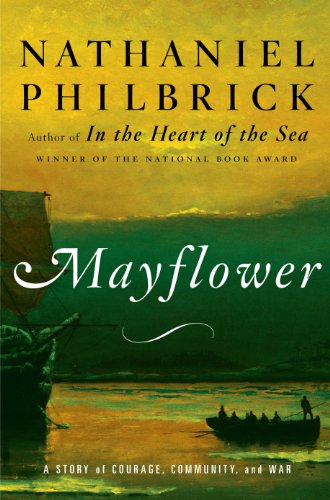These books from National Book Award winner Nathaniel Philbrick transport the reader back to crucial turning points in history with insightful, brisk narratives that make the study of history anything but boring.
Valiant Ambition: George Washington, Benedict Arnold, and the Fate of the American Revolution (5/5 stars, currently priced at $14.99)
From the New York Times bestselling author of In The Heart of the Sea and Mayflower comes a surprising account of the middle years of the American Revolution, and the tragic relationship between George Washington and Benedict Arnold.
In September 1776, the vulnerable Continental Army under an unsure George Washington (who had never commanded a large force in battle) evacuates New York after a devastating defeat by the British Army. Three weeks later, near the Canadian border, one of his favorite generals, Benedict Arnold, miraculously succeeds in postponing the British naval advance down Lake Champlain that might have ended the war. Four years later, as the book ends, Washington has vanquished his demons and Arnold has fled to the enemy after a foiled attempt to surrender the American fortress at West Point to the British. After four years of war, America is forced to realize that the real threat to its liberties might not come from without but from within.
Valiant Ambition is a complex, controversial, and dramatic portrait of a people in crisis and the war that gave birth to a nation. The focus is on loyalty and personal integrity, evoking a Shakespearean tragedy that unfolds in the key relationship of Washington and Arnold, who is an impulsive but sympathetic hero whose misfortunes at the hands of self-serving politicians fatally destroy his faith in the legitimacy of the rebellion. As a country wary of tyrants suddenly must figure out how it should be led, Washington’s unmatched ability to rise above the petty politics of his time enables him to win the war that really matters.
In the Heart of the Sea: The Tragedy of the Whaleship Essex (4.5/5 stars, currently priced at $13.99)
In the Heart of the Sea brings to new life the incredible story of the wreck of the whaleship Essex–an event as mythic in its own century as the Titanic disaster in ours, and the inspiration for the climax of Moby-Dick. In a harrowing page-turner, Nathaniel Philbrick restores this epic story to its rightful place in American history.
In 1820, the 240-ton Essex set sail from Nantucket on a routine voyage for whales. Fifteen months later, in the farthest reaches of the South Pacific, it was repeatedly rammed and sunk by an eighty-ton bull sperm whale. Its twenty-man crew, fearing cannibals on the islands to the west, made for the 3,000-mile-distant coast of South America in three tiny boats. During ninety days at sea under horrendous conditions, the survivors clung to life as one by one, they succumbed to hunger, thirst, disease, and fear.
In the Heart of the Sea tells perhaps the greatest sea story ever. Philbrick interweaves his account of this extraordinary ordeal of ordinary men with a wealth of whale lore and with a brilliantly detailed portrait of the lost, unique community of Nantucket whalers. Impeccably researched and beautifully told, the book delivers the ultimate portrait of man against nature, drawing on a remarkable range of archival and modern sources, including a long-lost account by the ship’s cabin boy. At once a literary companion and a page-turner that speaks to the same issues of class, race, and man’s relationship to nature that permeate the works of Melville, In the Heart of the Sea will endure as a vital work of American history.
Mayflower (4.5/5 stars, currently priced at $8.99)
From the perilous ocean crossing to the shared bounty of the first Thanksgiving, the Pilgrim settlement of New England has become enshrined as our most sacred national myth. Yet, as bestselling author Nathaniel Philbrick reveals in his spellbinding new book, the true story of the Pilgrims is much more than the well-known tale of piety and sacrifice; it is a fifty-five-year epic that is at once tragic, heroic, exhilarating, and profound.
The Mayflower’s religious refugees arrived in Plymouth Harbor during a period of crisis for Native Americans as disease spread by European fishermen devastated their populations. Initially the two groups—the Wampanoags, under the charismatic and calculating chief Massasoit, and the Pilgrims, whose pugnacious military officer Miles Standish was barely five feet tall—maintained a fragile working relationship. But within decades, New England would erupt into King Philip’s War, a savagely bloody conflict that nearly wiped out English colonists and natives alike and forever altered the face of the fledgling colonies and the country that would grow from them.
With towering figures like William Bradford and the distinctly American hero Benjamin Church at the center of his narrative, Philbrick has fashioned a fresh and compelling portrait of the dawn of American history—a history dominated right from the start by issues of race, violence, and religion.
Sea of Glory: America’s Voyage of Discovery, The U.S. Exploring Expedition, 1838-1842 (4.5/5 stars, currently priced at $12.99)
America’s first frontier was not the West; it was the sea, and no one writes more eloquently about that watery wilderness than Nathaniel Philbrick. In his bestselling In the Heart of the Sea Philbrick probed the nightmarish dangers of the vast Pacific.
Now, in an epic sea adventure, he writes about one of the most ambitious voyages of discovery the Western world has ever seen–the U.S. Exploring Expedition of 1838-1842. On a scale that dwarfed the journey of Lewis and Clark, six magnificent sailing vessels and a crew of hundreds set out to map the entire Pacific Ocean and ended up naming the newly discovered continent of Antarctica, collecting what would become the basis of the Smithsonian Institution.
Combining spellbinding human drama and meticulous research, Philbrick reconstructs the dark saga of the voyage to show why, instead of being celebrated and revered as that of Lewis and Clark, it has–until now–been relegated to a footnote in the national memory.
Winner of the Theodore and Franklin D. Roosevelt Naval History Prize
“A treasure of a book.” — David McCullough
A New York Times Notable Book
Bunker Hill: A City, A Siege, A Revolution (4.5/5 stars, currently priced at $10.99)
Nathaniel Philbrick brings his prodigious talents to the story of the Boston battle that ignited the American Revolution.
Boston in 1775 is an island city occupied by British troops after a series of incendiary incidents by patriots who range from sober citizens to thuggish vigilantes. After the Boston Tea Party, British and American soldiers and Massachusetts residents have warily maneuvered around each other until April 19, when violence finally erupts at Lexington and Concord. In June, however, with the city cut off from supplies by a British blockade and Patriot militia poised in siege, skirmishes give way to outright war in the Battle of Bunker Hill. It would be the bloodiest battle of the Revolution to come, and the point of no return for the rebellious colonists.
Philbrick brings a fresh perspective to every aspect of the story. He finds new characters, and new facets to familiar ones. The real work of choreographing rebellion falls to a thirty-three year old physician named Joseph Warren who emerges as the on-the-ground leader of the Patriot cause and is fated to die at Bunker Hill. Others in the cast include Paul Revere, Warren’s fiancé the poet Mercy Scollay, a newly recruited George Washington, the reluctant British combatant General Thomas Gage and his more bellicose successor William Howe, who leads the three charges at Bunker Hill and presides over the claustrophobic cauldron of a city under siege as both sides play a nervy game of brinkmanship for control.
With passion and insight, Philbrick reconstructs the revolutionary landscape—geographic and ideological—in a mesmerizing narrative of the robust, messy, blisteringly real origins of America.
The Last Stand: Custer, Sitting Bull, and the Battle of the Little Bighorn (4.5/5 stars, currently priced at $14.99)
Little Bighorn and Custer are names synonymous in the American imagination with unmatched bravery and spectacular defeat. Mythologized as Custer’s Last Stand, the June 1876 battle has been equated with other famous last stands, from the Spartans’ defeat at Thermopylae to Davy Crockett at the Alamo.
In his tightly structured narrative, Nathaniel Philbrick brilliantly sketches the two larger-than-life antagonists: Sitting Bull, whose charisma and political savvy earned him the position of leader of the Plains Indians, and George Armstrong Custer, one of the Union’s greatest cavalry officers and a man with a reputation for fearless and often reckless courage. Philbrick reminds readers that the Battle of the Little Bighorn was also, even in victory, the last stand for the Sioux and Cheyenne Indian nations. Increasingly outraged by the government’s Indian policies, the Plains tribes allied themselves and held their ground in southern Montana. Within a few years of Little Bighorn, however, all the major tribal leaders would be confined to Indian reservations.
Throughout, Philbrick beautifully evokes the history and geography of the Great Plains with his characteristic grace and sense of drama. The Last Stand is a mesmerizing account of the archetypal story of the American West, one that continues to haunt our collective imagination.
* * *
Tech Tip of the Week: Wrap Your E-Z Pass In Foil Before Returning It
* * *






